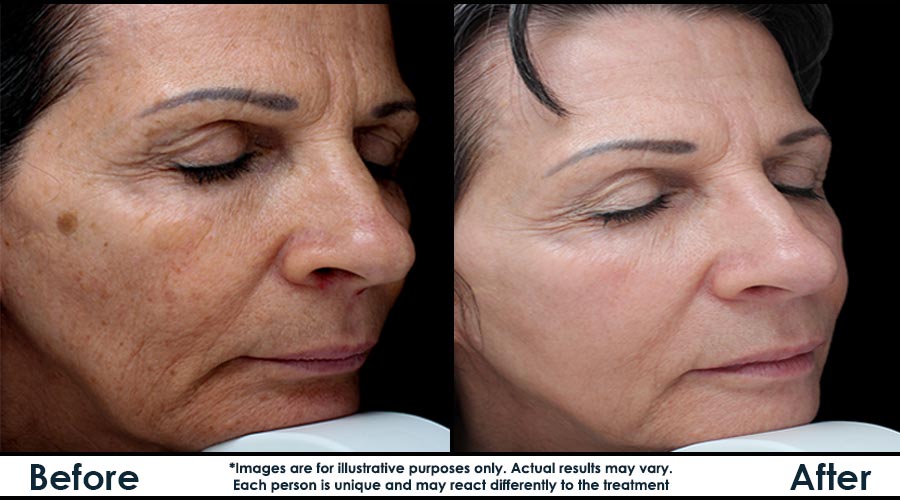Dark Spots, Sun Spots, Age Spots, and Skin Bumps?
Advanced solutions to treat brown spots, melasma, and uneven skin tone
Results After Treatment for Dark Spots and Age-Related Lesions

A Targeted Approach to Dark Spots and Age-Related Lesions
1
In-depth consultation with advanced imaging to assess skin concerns and build your plan
2
A personalized treatment plan adapted to your skin and the nature of the spots being addressed
3
Start of Treatment & Follow-Up to ensure progress
What Are Dark Spots and Why Do They Appear?
Dark spots are caused by the overproduction of melanin in a specific area of the skin, whether on the face or the body. Melanin is made up of organic pigments in various colors black, brown, red, or yellow. The combination and concentration of these colors determine the tone of our skin, hair, and eyes. Melanin also serves as a natural defense against ultraviolet radiation, which can damage cell DNA. The darker the melanin, the better the skin is protected from sun exposure.
The cells that produce melanin are called melanocytes. Interestingly, all humans have the same number of melanocytes, regardless of skin color. So why do we see different skin tones? It’s due to the level of activity of these cells. Think of melanocytes as tiny ink taps: when they open, melanin is produced in the deeper layers of the skin and gradually moves to the surface. The longer they remain open, the more melanin is released resulting in darker skin. In fair skin, these taps tend to open quickly with sun exposure and close again when exposure stops.
Now that we understand this mechanism, we can see how dark spots appear when melanocytes become unbalanced or overstimulated often due to prolonged sun exposure. These spots tend to remain visible and can increase over time. They commonly begin to appear around the age of 30. Fair-skinned individuals are more susceptible, as their melanocytes react more strongly to UV light. In darker skin, these spots are more likely to form following inflammation, such as after acne, leaving behind long-lasting marks. Hormonal fluctuations, such as during pregnancy or from taking certain medications, can also disrupt melanocyte activity and lead to the appearance of facial discoloration.
Most common types of dark spots we treat:
- Pigment spot caused by a scar, such as a pimple;
- Hormonal hyperpigmentation;
- Pregnancy mask;
- Age spot that appears after quarantine;
- Solar Lentigo or Sunspot.
How Dark Spots Form on the Skin

Causes of Dark Spots, Age Spots, and Common Skin Lesions
- Scars from an injury or pimple.
- Hormonal fluctuations in women related to their menstrual cycle.
- Certain medications or hormones.
- Inflammation of the follicles after shaving.
- Pregnancy.
- Sun exposure.
- Genetic, hereditary or other factors.
- Disruption of melanocytes as they age.
Our Approach
We use a personalized approach to determine the most appropriate treatment for your skin. The first step is a thorough analysis to identify the type, depth, and origin of the spots present. While many are caused by sun exposure, others may be linked to age-related skin changes, such as seborrheic keratoses or accumulated cellular buildup. Each requires a different therapeutic approach.
Our 3D imaging system allows us to visualize what’s happening beneath the surface of the skin and across its different layers. It also helps us assess the intensity, distribution, and nature of the areas to be treated whether they are melanin-based discoloration or thickened, textured lesions. Based on this advanced analysis, we create a customized treatment plan adapted to your skin’s unique condition.
It’s important to understand that using a single laser or a standard protocol is rarely effective. For example, spots triggered by sun exposure are often caused by inflammation and overheating of the skin, which overstimulate melanin production. Treating these spots with laser without addressing the inflammatory state may lead to inconsistent results. Some clients may see short-term improvements, while others may experience recurrence or worsening if the treatment is not precisely matched to the cause.
Many people consult us for spots that appear after the age of 40. These are often assumed to be simple sun spots, but in reality, a large number are age-related skin growths, most commonly seborrheic keratoses. These are not caused by excess pigment, but rather by a buildup of dry, thickened, horn-like skin cells. They often appear rough, raised, and brownish frequently mistaken for sun damage.
Most aesthetic clinics only offer IPL (intense pulsed light) treatments, which may help fade superficial discoloration, but are not sufficient to eliminate textured age spots like keratoses. These require complementary technologies, including ablative lasers, targeted resurfacing, or gentle surgical techniques. At Infinium Clinic, we regularly treat patients who have previously undergone sessions elsewhere, only to find that the most persistent spots remained simply because the true nature of the lesion was never identified or properly treated. IPL may slightly fade them, but cannot remove them.
That’s why our method goes beyond color analysis. We perform a comprehensive evaluation, taking into account the texture, thickness, and structure of each spot. With over 40 advanced technologies available in-clinic, we can address both pigment-based issues and age-related lesions like keratoses in the same personalized treatment plan ensuring precise, safe, and long-lasting results.



